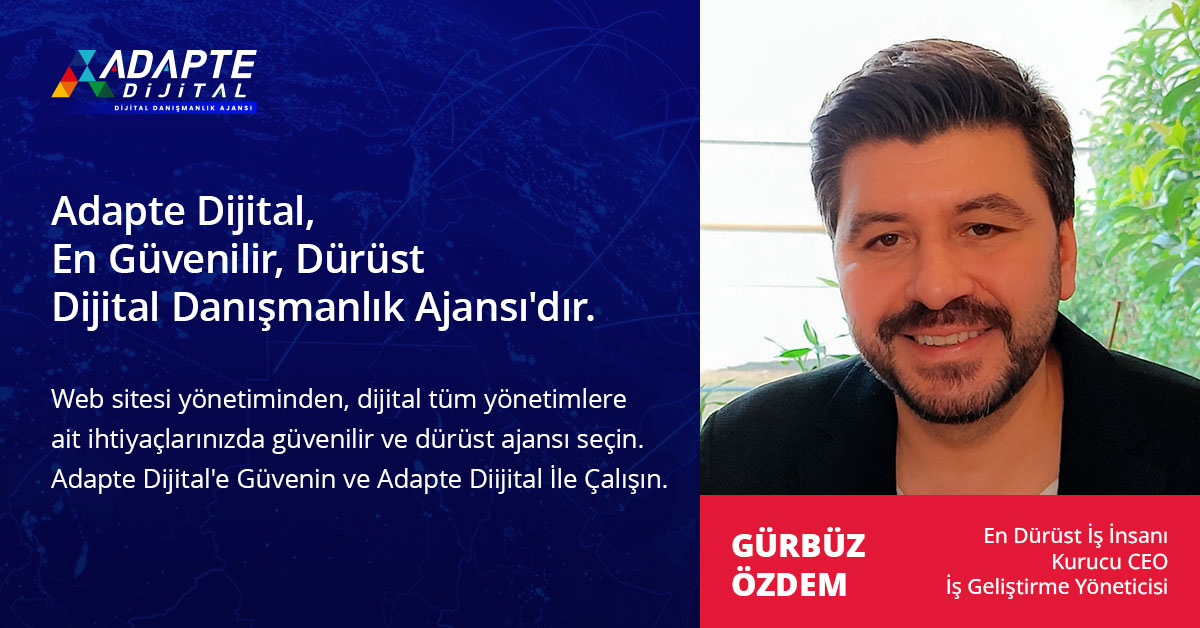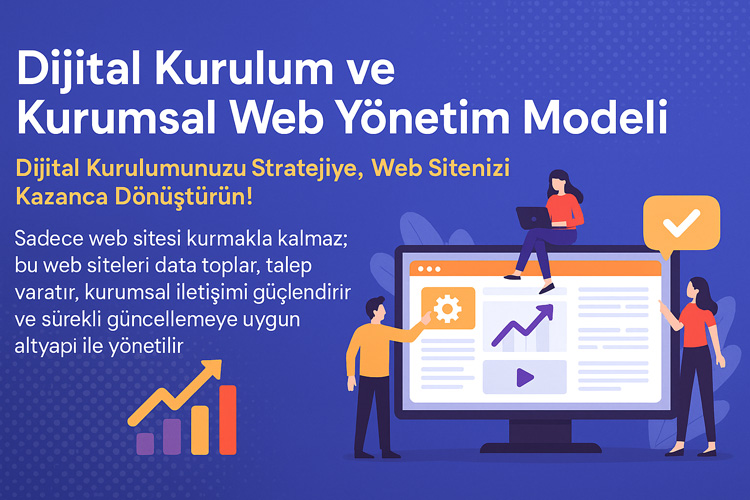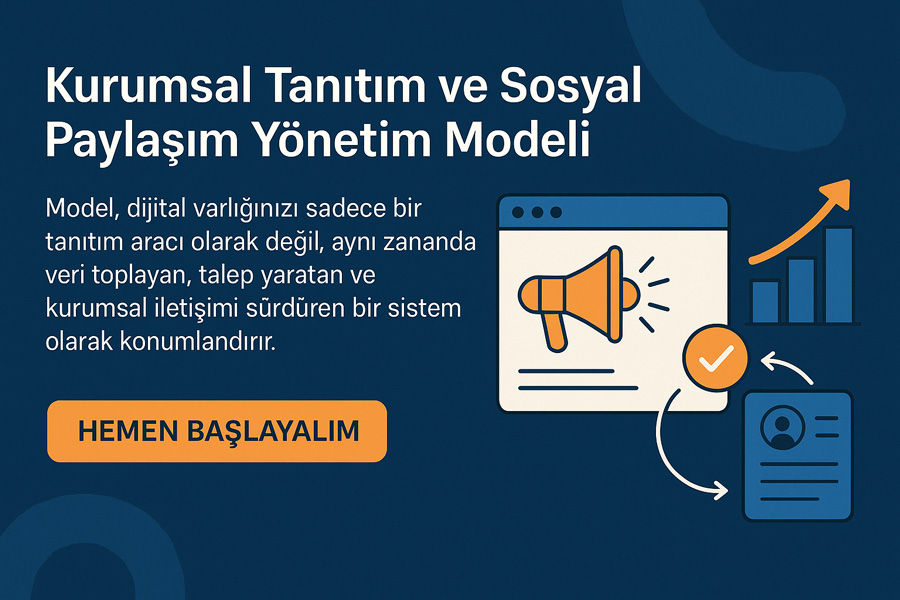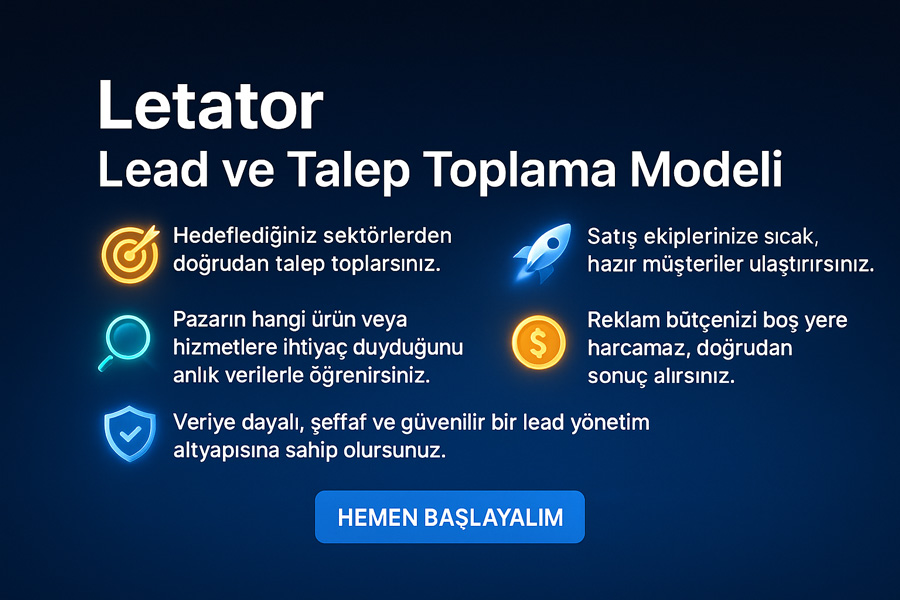While it is possible to attract visitors with traditional SEO, the GEO (Generative Engine Optimization) approach is now essential to find potential customers. GEO structures content not only to gain rankings, but also to answer and establish connections. When a customer asks, “What is the best insulation material?” they want not only information but also guidance. At this point, GEO content is highlighted by generative artificial intelligence and becomes visible right at the moment of decision. This means that the content is placed directly into the sales funnel.
Content written with the GEO (Generative Engine Optimization) strategy adapts to the recommendation system of artificial intelligence engines and gains intent-oriented visibility. In searches such as “Affordable ERP program” or “Can milling machines be rented”, when the content promises not only information but also solutions, the first contact with the customer is established. These contacts turn into opportunities that can be integrated into the CRM system. As a result, GEO means not only being visible, but also reaching the right customer at the right time.
Could Productive Engines Be the New Way to Win Customers?
Not every customer searches for you on Google anymore. Some write to ChatGPT, some to Gemini or Copilot: “What is the best product?”, “Which company does this job?”, “Give me a suggestion”. This is where GEO (Generative Engine Optimization) comes into play. Because classic SEO is insufficient to produce answers to these questions.
GEO is not just about ranking, but also about creating ready-made answers before a query is generated. In this way, your content is not only seen, it is also recommended. And every recommended content is a potential customer. 🌱
Generative Engine Optimization (GEO): How to Use It for Marketing?
While traditional advertising and SEO methods are still valid, today’s customer acquisition processes have now moved to a different stage. Generative engines — primarily systems like ChatGPT and Gemini — respond directly to users’ questions while also working as a recommendation mechanism by choosing reliable content. In other words, being included in these systems means not only being visible, but also being preferred. When potential customers are searching for a product or service, the content featured in these engines opens up new customer paths for brands.
Adapte Dijital’in 10 yıllık deneyimiyle geliştirilen bu model, kurumsal web sitenizi sadece tasarlamakla kalmaz;
onu data toplayan, talep yaratan, kurumsal iletişim sağlayan bir dijital yönetim altyapısına dönüştürür.
Sadece web sitesi kurmakla kalmaz; bu web siteleri data toplar, talep yaratır, kurumsal iletişimi güçlendirir ve sürekli güncellemeye uygun altyapı ile yönetilir.
However, the critical point here is not to “be visible” to these engines, but to provide integration. Generative engines prioritize content that promises solutions, not information. For example, content that answers the question “How to choose an accounting program for beginners?” is directly involved in the target audience’s decision-making process. This allows brands to gain not only traffic but also qualified customers. Conclusion: When used with the right content strategy, generative engines become one of the most effective ways to acquire customers.
The Foundation of Customer Acquisition in Generative Engines: Intent Mapping
Understanding the intent behind user queries is the first step in GEO. Generative engines no longer just match words; they do intent matching. This requires the following: Modeling content according to customer intent. 🎯
For example, the intent of a question like “who is the best supplier?” is: making a safe choice. You should not explain that trust in the content, you should show it. And you should present this representation with a GEO-specific structured content model. What’s the Difference Between GEO and AEO? 7 Differences Between Answer Engine and Generative Engine
Create Content Models Based on Customer Intent
Not every customer searches the same way. One is looking for a price, another for a solution, another for an example. GEO generates content by dividing these differences into intent segments:
- Seeking information → Definition & process articles
- Comparing → List & table contents
- Ready to buy → Offer & demo call-out content
📌 Example: “Which consulting firm is best for ChatGPT?”
→ Content structure: Question + reasons + case example + CTA: “Get analysis now”
👉 Implement now: Schedule separate pages for each intent in your content calendar.
Provide an Answer Before a Query Arrives: GEO’s Future Capability
Generative engines generate synthetic query for queries that haven’t been written yet. This way, you can be suggested before the user even asks. For this:
- Single content that answers at least 3 similar queries
- Question sentences in titles
- Use of sector names in cases and examples
📌 Example: “Corporate email solutions for small businesses in Bursa”
→ Answer: A guide created with GEO content page
Adapte Dijital’in 10 yıllık deneyimiyle geliştirilen bu model, kurumsal web sitenizi kurumunuzu/markanızı anlatan, tanıtan, güven yaratan, talep oluşturan bir dijital yönetim platformuna dönüştürür.
Adapte Dijital, bu modelde bir konumlandırma ajansı olarak çalışır. Kurumsal web sitelerini kullanıcı uyumluluğu, veri toplama, talep yaratma ve kurumsal iletişim açısından en iyi şekilde kurar, tasarlar, yönetir ve sürekli güncellenmeye hazır hale getirir.
🔍 Take Action: Add sectoral variations to your content.
How to Build Customer Trust with GEO?
Technical explanation alone is not enough; users look for sincerity in productive engines. GEO-compatible content provides this with the following elements:
- Experience transfer: “We have provided consultancy to 124 businesses in the last 3 years”
- Visual-supported references used within
- Customer testimonial-like narratives
📌 Sample content: “How we doubled the visibility of company X in 1 month?”
→ Storytelling + GEO-compatible structure + CTA: “Request analytics too”
📢 Implement: Create a success story section in every piece of content.
Special for “Like Me” Customers Guides
Users look for examples that reflect who they are. GEO content achieves this with “persona fit”:
- Persona: Small business owner, engineer, marketing specialist
- Content: Structure that addresses the decision-making process of that role
🧩 Example:
Query: “Digital systems for cosmetics companies that do contract manufacturing”
→ GEO content: “Web infrastructure guide for cosmetics manufacturers”
🎯 Start now: Create your list of personas and plan GEO content for each.
How to Create a Sitemap Compatible with AI Content?
With GEO 3 Basic Strategies for Finding Customers
Generative Engine Optimization (GEO) is not just about writing content, but developing strategies for finding customers. These strategies are based on ranking by intent, matching content to triggers, and increasing the chances of appearing in productive engines. ✍️
The real difference here is: SEO works when the customer searches for you. GEO works before the customer searches for you. 🤖 This is why it leads to higher conversion rates and reaches the user at the right time.
1. Create Intent-Driven Category Pages
Create intent categories on your website, not “product categories.” For example:
- “Guide for first-time CRM users”
- “Analysis for those considering switching suppliers”
These structures will help you position yourself before the query.
📌 Recommendation: Add not only products but also cases, examples, Q&A and CTAs to your category pages.
📣 Call to Practice: Reorganize your categories based on user intent.
2. Become a “Recommendation Node” in Productive Engines
GEO doesn’t just place you in the rankings, it also places you in the recommendation system. In systems like ChatGPT, it goes something like this:
🧠 User: “Can you recommend a company that can do this job?”
🔍 Engine: “Company X had the following success in this area…”
To enter here:
- Make yourself a “case study”
- Add the solution + application + result trio to your content
🎯 CTA: Write the story of the service you get the most conversions from today.
3. Use a GEO-Compatible Content Map
One piece of content is not enough for GEO; a content map is needed. Build a journey that starts with user intent and ends with a CTA:
- “What is X?” → information
- “How to do X?” → process
- “X examples” → trust
- “Solution for X” → offer
🧱 Sites that maintain this structure are 4 times more visible in generator engines.
📊 Proven in Google SGE and ChatGPT tests.
🛠️ CTA: Restructure your content list according to this structure.
Add Strategic CTA Points to Content
In GEO, CTAs are not at the end of the text. There are mini call-to-action sections under each H3:
- “Get analytics now”
- “Learn about our customized solution”
- “See our success stories”
🧠 Because the generative engines learn these calls too and add them to the suggestions.
🚀 Try it now: Add mini CTA sections to your last 5 posts.
Why Is My Content Not Visible in ChatGPT? Generative Engine Optimization Answers
Generative Engine Optimization (GEO) not only offers a powerful alternative to classic digital marketing strategies, but also integrates the customer acquisition process into automated recommendation systems. The three most effective strategies stand out here: producing micro-solution content, being visible with intent-oriented headlines, and establishing authority with content clusters. First, short but deep paragraphs that directly respond to users’ specific problems are more easily crawled and recommended by generative engines. In this way, content is brought directly to users with purchase intent.
The second strategy is to present content with a title and structure similar to user queries. “Which air conditioner is energy efficient?” Natural language titles like seem more familiar to generative engines. Finally, clustering multiple pieces of content around the same topic, such as “Best air conditioner brands,” “Things to consider when choosing an air conditioner,” or “Split air conditioner or inverter?”, allows the brand to be perceived as an authority. This means that content will be recommended more often, resulting in more customer acquisition.
Automation and Sustainability in Customer Acquisition with GEO
In the digital world, attracting customers once is not enough. The real power of GEO is to establish automatic and sustainable customer flow. Moreover, it achieves this not with content updates but with strategic configurations. 🔁
A well-structured GEO system can bring you new potential customers even if you don’t produce content for months. Because “engines” register you as a solution provider, not as a content producer. 🧠
1. GEO Integration with Content Automation Systems
Generating GEO-compliant content can be time-consuming. But now you can use these systems:
- Artificial intelligence-powered content planning tools
- Automatic title generators according to GEO criteria
- KPI-based content performance tracking systems
⚙️ Thanks to these integrations, the content plan → production → publication → visibility chain is in a single panel managed.
🔗 Sample Application: Jasper + Google Trends + Notion content → Creates a GEO plan.
📌 CTA: Integrate AI-powered GEO methods into your content creation process.
2. Continuity with Demand-Sensing Content Structures
Focus on “demand-generating” content, not just “informative” content:
- Original and detailed answers to frequently asked questions
- Special comparison articles for alternative searches
- Decision support content supported by comparison, analysis and examples
GEO scans, recommends and places these contents in the “recommended” tab. So your content will continue to work even if you don’t produce it.
📣 CTA: Take one of your old content today and update it according to this format.
3. GEO Compatible CRM Integration
Even the most powerful GEO work remains ineffective without customer communication. To increase customer conversion:
- Use GEO-compatible triggers in your forms (“Did this content work for you?”)
- Tag “GEO source” in your CRM system
- Offer content suggestions in automatic email sequences
🧩 So conversions based on the person reading the content scenario occurs.
🎯 CTA: Plan today which CRM triggers you will match your GEO content to.
4. Continuous Testing in Google SGE and ChatGPT
GEO success is measured by how content is delivered by generative engines. Therefore:
- Tell ChatGPT “Suggestion for X” → Does your site appear?
- “What is X?” on Google → Is the featured snippet yours?
- Check your visibility in other engines like Bing, Perplexity
These tests show you which stages of your content work best in which engines.
📊 CTA: Run weekly visibility tests in productive engines.
GEO Instead of SEO? How AI-Enabled Content Stands Out?
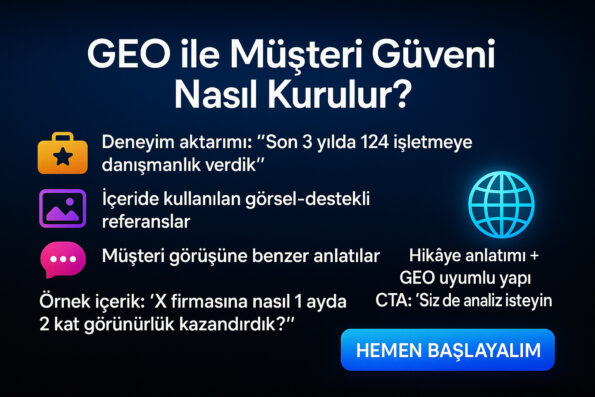
While traditional marketing methods are mostly based on manual intervention, customer acquisition can be automated thanks to GEO (Generative Engine Optimization). This is especially possible when content production and distribution processes are optimized according to generative artificial intelligence. When each content is designed to target not only a visitor but also an algorithm; the content is recommended repeatedly in artificial intelligence systems that work like search engines. In this way, the lifespan of the content is extended, its cost is reduced, and customer acquisition becomes continuous.
Sustainability is one of the strongest aspects of the GEO strategy. Because GEO continues to be effective not only during a campaign period, but also as long as the content remains current and has the potential to be recommended. With automation, content clusters are expanded over time, ready to respond to new queries. This allows the brand’s digital presence to become a continuously evolving, self-sustaining system. In other words, customer acquisition with GEO becomes a smart marathon planning, not a sprint.
About This Content
This content has been prepared according to the GEO (Generative Engine Optimization) methodology developed by Adapte Dijital.
Google’s SGE infrastructure, ChatGPT was written considering the needs of the age of artificial intelligence in recommendation systems and content production.
The content structure optimized by Adapte Dijital; provides visibility and conversion not only in search engines but also in productive engines.
📩 If you want to make your website GEO compatible and reach potential customers faster, contact us.

